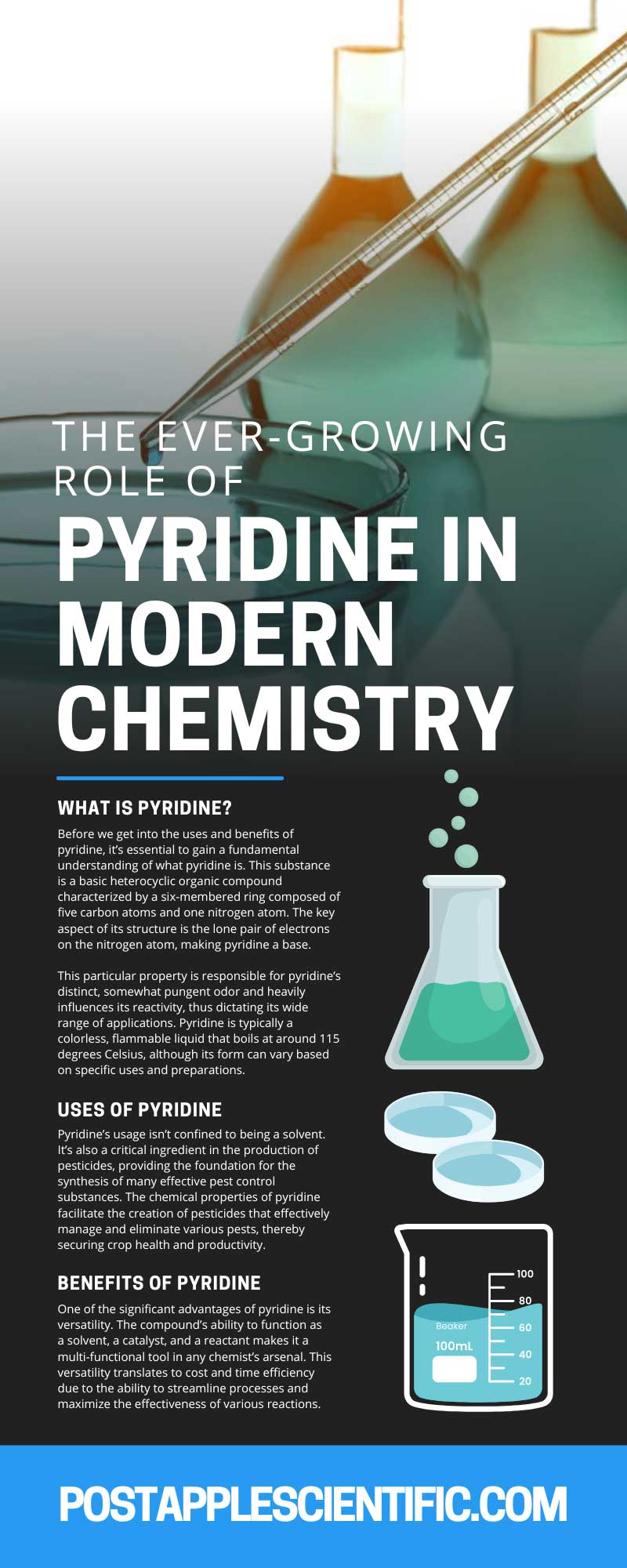One of the most important substances in the world of modern chemistry is pyridine. This simple yet potent organic compound finds its place in numerous industrial applications, demonstrating its importance in today’s chemical landscape. Read on to discover the ever-growing role of pyridine in modern chemistry, including its uses, the benefits it brings, and the considerations one must keep in mind while using it.
What Is Pyridine?
Before we get into the uses and benefits of pyridine, it’s essential to gain a fundamental understanding of what pyridine is. This substance is a basic heterocyclic organic compound characterized by a six-membered ring composed of five carbon atoms and one nitrogen atom. The key aspect of its structure is the lone pair of electrons on the nitrogen atom, making pyridine a base.
This particular property is responsible for pyridine’s distinct, somewhat pungent odor and heavily influences its reactivity, thus dictating its wide range of applications. Pyridine is typically a colorless, flammable liquid that boils at around 115 degrees Celsius, although its form can vary based on specific uses and preparations.
Uses of Pyridine
Now that you have a basic understanding of what pyridine is, let’s discuss some of its many uses.
As a Solvent
One of the major roles pyridine plays in the modern lab is that of a solvent. Thanks to its polar nature and ability to donate and accept electrons, pyridine serves as an effective solvent for a diverse array of substances.
Pyridine can dissolve a variety of salts and polar organic molecules, making it an invaluable component in numerous chemical processes. The use of pyridine as a solvent extends to several industries, including pharmaceuticals, agrochemicals, and others, which helps prove its widespread relevance.
In the Production of Pesticides
Pyridine’s usage isn’t confined to being a solvent. It’s also a critical ingredient in the production of pesticides, providing the foundation for the synthesis of many effective pest control substances. The chemical properties of pyridine facilitate the creation of pesticides that effectively manage and eliminate various pests, thereby securing crop health and productivity.
In Pharmaceutical Applications
The pharmaceutical industry also benefits immensely from pyridine. The compound’s ability to undergo a wide array of chemical reactions makes it a crucial component in the synthesis of numerous therapeutic drugs. By acting as a chemical building block, pyridine allows for the development of complex molecular structures necessary for various pharmaceutical compounds, contributing significantly to healthcare and medicine.
In Synthetic Processes
Another arena where pyridine shines is synthetic chemistry. Pyridine’s structure and reactivity make it a versatile reagent in a plethora of synthetic procedures. It serves as a catalyst, a nucleophilic agent, and even a reducing agent in different chemical reactions. This versatility empowers chemists to design and execute complex synthetic routes, enhancing the breadth and depth of chemical synthesis.
Benefits of Pyridine
Pyridine’s utility extends beyond its chemical properties and functional roles, providing a multitude of benefits that prove its value to modern chemistry.
Versatility
One of the significant advantages of pyridine is its versatility. The compound’s ability to function as a solvent, a catalyst, and a reactant makes it a multi-functional tool in any chemist’s arsenal. This versatility translates to cost and time efficiency due to the ability to streamline processes and maximize the effectiveness of various reactions.
Adaptability
Pyridine’s reactivity can be adjusted to suit specific needs. By making slight alterations to the structure of pyridine, chemists can modulate its reactivity, enhancing the efficiency and specificity of reactions. This adaptability is a major advantage in both research and industrial applications, where the ability to design tailored solutions can often determine the success or failure of a project.
Practicality
Another benefit of pyridine is its practicality. Its ready availability and relative ease of handling ensure that pyridine can be incorporated into various processes without significant logistical hurdles. This makes it a logical choice across a wide range of sectors, from laboratory research to large-scale industrial processes.
Contribution to Innovative Research and Development
The use of pyridine has greatly facilitated innovative research and development in various industries, such as pharmaceuticals and agrochemicals. Its unique properties have led to breakthroughs in the synthesis of new compounds and the development of new synthetic routes. Therefore, pyridine is not just a tool, but also a catalyst for innovation in modern chemistry.
Considerations When Using Pyridine
Pyridine is beneficial in several respects, but there are still important considerations to bear in mind when using it.
Safety Precautions
First and foremost, those working with pyridine must adhere to safety precautions meticulously. Pyridine is a toxic substance that can cause irritation to the eyes, skin, and respiratory tract. It’s crucial to handle pyridine in a well-ventilated environment, preferably under a fume hood, wearing appropriate personal protective equipment (PPE) such as gloves and safety goggles.
Environmental Impact
Secondly, the environmental impact of pyridine must be accounted for. Improper disposal of pyridine can harm the environment, so it’s essential to follow regulatory guidelines regarding waste management. Also, consider exploring greener alternatives or recycling methods if applicable.
Storage and Stability
Finally, the storage and stability of pyridine are important factors. Pyridine should be stored in a cool, dry, well-ventilated place, away from sources of ignition and incompatible materials. Over time, pyridine can form explosive peroxides upon exposure to air, so containers should be checked periodically and tightly sealed when not in use.
The Evolving Role of Pyridine
Pyridine’s role in modern chemistry is constantly evolving as new applications and potentials are discovered. Its significant contribution to the field of pharmaceuticals, where it aids in the development of lifesaving drugs, underlines its growing importance. Moreover, its use in environmental science as a tool for pollution control further emphasizes its expanding role.
Now that you understand the ever-growing role of pyridine in modern chemistry, it’s clear to see why this versatile compound is gaining prominence. Its varied applications, from serving as a key solvent to facilitating the production of lifesaving pharmaceuticals, underscore its unique capabilities and potential for future developments.
However, as we embrace pyridine’s uses and benefits, it remains crucial to respect the safety considerations it demands, ensuring its application continues to contribute positively to our industries and environment. If you need this compound for your laboratory, Post Apple Scientific has pyridine for sale in our online store. With all the research and exploration taking place, pyridine’s role in shaping the future of modern chemistry is truly intriguing.


